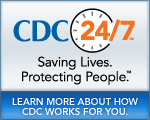MMWR
Morbidity and Mortality Weekly Report
MMWR News Synopsis for July 30, 2009
- Laboratory-Confirmed Vaccinia Virus Infection a€“ Virginia, 2008
- Fatalities Caused by Cattle a€“ Four States, 2003-2008
- Status of the National Electronic Disease Surveillance System a€“ United States, 2007
There is no MMWR telebriefing scheduled for July 30, 2009.
Laboratory-Confirmed Vaccinia Virus Infection a€“ Virginia, 2008
Press Contact: Division of Media Relations
Phone: (404) 639-3286
Researchers working with vaccinia virus, the live viral component of smallpox vaccines, should follow vaccination recommendations from the Advisory Committee on Immunization Practices (ACIP). Every year CDC receives reports of accidental exposure to vaccinia virus in laboratory workers. In 2008 an unvaccinated laboratory worker in Virginia was diagnosed with vaccinia virus infection. An extensive contact investigation of 102 potential contacts in 2 states was undertaken to identify any transmitted cases. None were found. Researchers working with vaccinia virus should follow vaccination recommendations from the ACIP. Exposure to the virus, either from an infected individual or from someone who recently received smallpox vaccine, can result in infection and severe complications can occur in persons having underlying risk factors (e.g., pregnancy, immunodeficiencies, and dermatological conditions).
Fatalities Caused by Cattle a€“ Four States, 2003-2008
Press Contact: Wayne T. Sanderson, Associate Professor, Occupational & Environmental Health, University of Iowa
Phone: (319) 335-4207
Livestock farmers are at risk of being injured and killed by cattle and precautions should be taken to prevent close contact, especially with aggressive cattle. National occupational death surveillance data shows that on average 20 deaths per year are caused by cattle on U.S. farms, but little is known about the circumstances of these deaths. Surveillance and follow-up of cattle-related deaths reported in the news media in Iowa, Kansas, Missouri, and Nebraska during 2003a€“2008 showed that fatalities occur throughout the year and that older farmers are especially at risk. The circumstances associated with these deaths involved working with cattle in enclosed areas (33 percent), moving or herding cattle (24 percent), loading (14 percent), and feeding (14 percent). One third of the deaths were caused by animals which had previously exhibited aggressive behavior. To reduce lives lost, farmers and ranchers should improve their livestock-handling facilities to prevent close contact and take precautions when working with cattle, especially cattle that have exhibited aggressiveness in the past.
Status of the National Electronic Disease Surveillance System a€“ United States, 2007
Press Contact: CDC, Division of Media Relations
Phone: (404) 639-3286
States are willing to commit to furthering the interoperability of their surveillance systems, but limited resources are the largest barrier to replacing aging electronic systems. Electronic disease surveillance systems within the United States have been developed in a multitude of ways. Many states use a combination of vendor products, CDC electronic systems, and state-developed surveillance systems to allow for customization for their public health needs. Results of a recent assessment illustrated the progress of electronic disease surveillance systems nationwide. Overall, statesa€? surveillance systems varied widely and were in various stages of implementation. As interoperability becomes the standard for electronic data sharing, more states will face customization costs and increasing demand for informaticians in the workforce. Surveillance and health-care IT stakeholders will need to support the growing electronic infrastructure and aim to improve the efficacy and quality of electronic disease surveillance systems.
####
- Historical Document: July 30, 2009
- Content source: Office of Enterprise Communication
- Notice: Linking to a non-federal site does not constitute an endorsement by HHS, CDC or any of its employees of the sponsors or the information and products presented on the site.
View Press Releases in
Get e-mail updates
To receive e-mail updates about this page, enter your
e-mail address:
Contact Us:
- Centers for Disease Control and Prevention
1600 Clifton Rd
Atlanta, GA 30333 - 800-CDC-INFO
(800-232-4636)
TTY: (888) 232-6348 - Contact CDC-INFO


